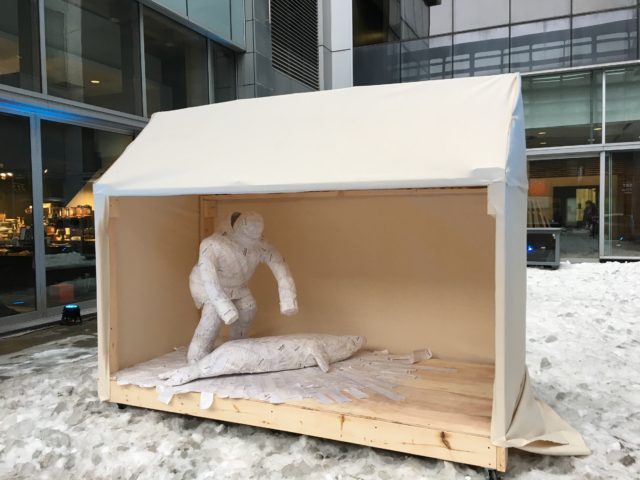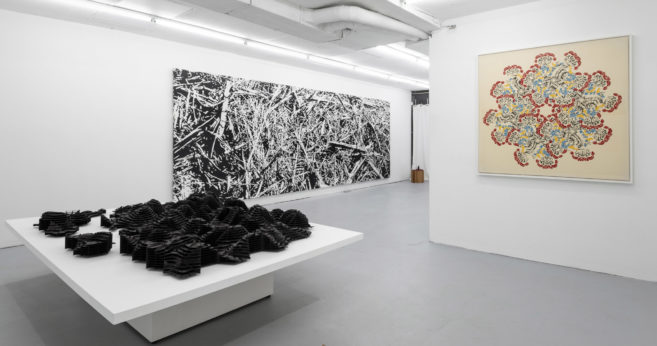Jesse Tungilik is a politically conscious multimedia artist based in Iqaluit. In the winter of 2019, he was an artist in residence at Concordia University, where his primary project was the creation of a sealskin spacesuit, which he produced in collaboration with local Inuit CEGEP students. Skin, both animal and human, is a powerful symbol for Indigenous artists, in part because it is the site of both violence and resilience. Major exhibitions have explored this symbolism, such as “Hide: Skin as Material and Metaphor,” which was organized in 2010 by the National Museum of the American Indian in New York. For artists, skin can bear the marks of trauma, but also reveal healing, as in Anishinaabe artist Nadia Myre’s The Scar Project (2005–).
In two recent works, Tungilik references the tradition of seal hunting in the Arctic, bringing a new approach to the use of skin, one that combines tradition and futurity by imagining a specifically Inuit-created spacesuit. Unlike artists who have employed animal skin to signify a connection with the earth and non-human others, Tungilik uses sealskin to create a “second skin” that, in an alternate reality, allows Inuit to explore beyond the earth’s boundaries.
The vernissage for Tungilik’s exhibition “The Making of a Seal Skin Spacesuit” was hosted at Concordia in late April 2019. During the vernissage, the full-body spacesuit—made of luxuriant sealskin that gleamed in the light and invited touch—was on display for just a few moments before being briefly donned by Jason Sikoak, an emerging Inuk artist and Concordia student. On the suit’s left shoulder is a beadwork patch for the imagined Inuit Space Program. People eagerly rushed up to the student wearing the suit in order to touch it, stroking the sealskin in a way that undermined the usual prohibition of touching artworks. In this way, Tungilik shapes the traditional material of sealskin into a future-oriented trajectory proposition for Inuit. The joyfulness with which the spacesuit was received shows how viewers were open to the conversation about survivance and intergenerational exchange called forth by Tungilik’s project.
Feeding My Family (2019), which was also on display at Concordia at the end of April, is a sculpture depicting a handless figure standing over a seal. The work was exhibited in the Milieux Institute for Arts, Culture and Technology building lounge, near a large window overlooking Montreal’s downtown core. The contrast between seal hunting, an Inuit tradition of survival and sustenance, and the dazzle of downtown Montreal was striking. From a distance, the sculpture looked like it could have been made out of marble or soapstone, but was in fact a papier mâché sculpture made out of receipts Tungilik collected from grocery stores in Pangnirtung and Iqaluit. For Tungilik, the work draws attention to the issue of food insecurity in the North; the absence of hands on the sculpture is meant to signify how many Inuit have been disconnected from traditions of hunting in their communities due to settler colonial violence. Indeed, the figure’s handlessness evokes a strong sense of powerlessness: it makes it impossible to skin the seal at their feet.
Unlike Feeding My Family, the sealskin spacesuit, a beautiful object, does not offer an explicit critique of settler colonialism. Still, these two works are two sides of the same coin: with Feeding My Family, Tungilik illuminates some of the consequences of colonial violence with a sculpture showing a seal that cannot be skinned. With the sealskin spacesuit, however, Tungilik reveals how the tradition of using sealskin for a range of purposes is not lost to the past, but instead will carry Inuit into the future.
On October 15th, 2019, it was clarified that artist Jason Sikoak was the Concordia student who wore the spacesuit during the vernissage for Tungilik’s exhibition “The Making of a Seal Skin Spacesuit.”

 Jesse Tungilik, Feeding My Family, 2019.
Jesse Tungilik, Feeding My Family, 2019.






